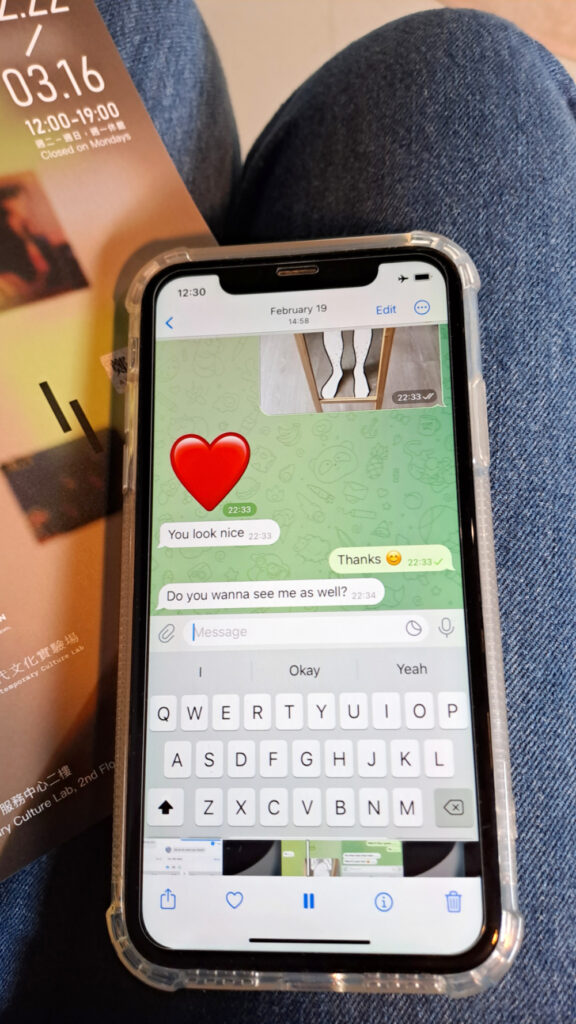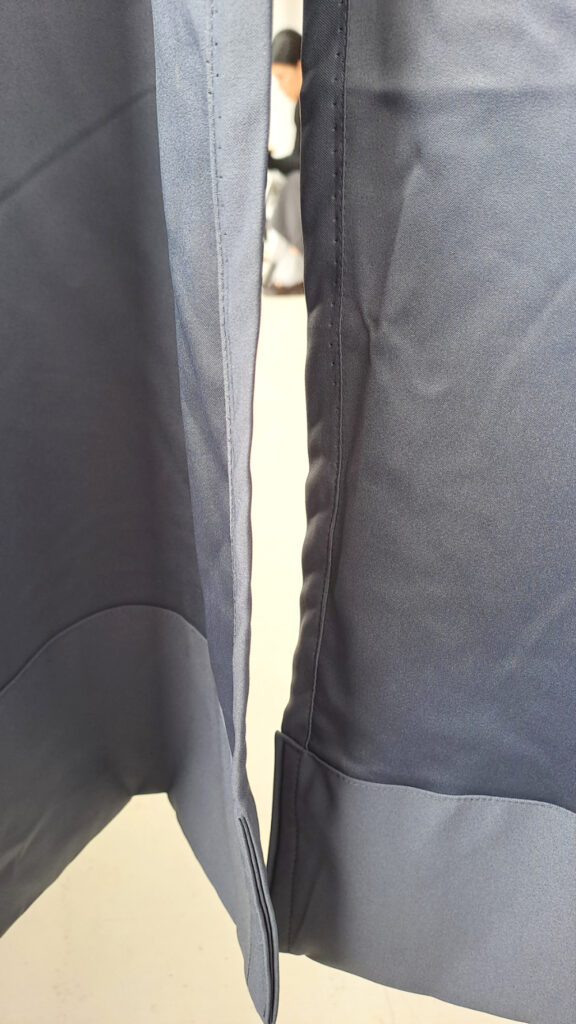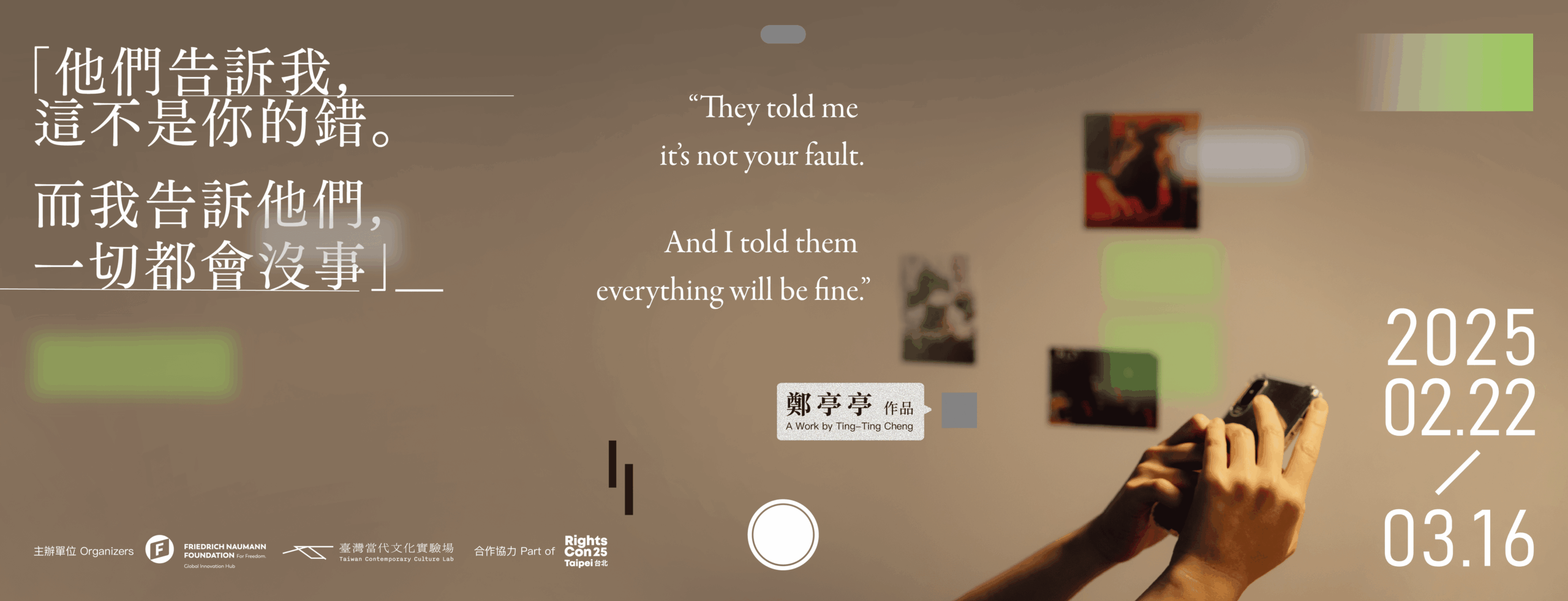
Exhibition details taken from Taiwan Contemporary Culture Lab.
As a visual art person, I often incorporate videos and visuals to illustrate the background of specific artworks.
However, this is not the case for Cheng Ting Ting’s work titled “They told me it’s not your fault. And I told them everything will be fine.”
I saw this exhibition in Taipei in February 2025. A participant at the Digital Rights Conference informed me about Cheng Ting Ting’s work in the Taiwan Contemporary Culture Lab. I did not know it was appointment-based because the participant told me that the Digital Rights Conference provided buses to transport people to view this exhibition. There was some miscommunication between the brochure announcement and the announcement at the Digital Rights Conference. The reason why this exhibition was appointment-based is because only one person can experience it at one time. Thankfully, there was an available slot for me.
I had a choice of immersing myself in the exhibition or taking pictures and videos to show readers about the immersive experience. I decided on the former, which is experiencing the exhibition. Hence, you will not see highlights of visuals or videos but a story of my experience going through it.
Background
Before I describe my experience, I would like to provide some background to situate the work and the artist’s intention. The Friedrich Naumann Foundation for Freedom commissioned her work, and the description is as below:
Discomfort of an immersive exhibition
It was my first time attending an immersive exhibition, where I followed cues communicated to me through their mobile phone. The cues were in video form, and I had to play the video and listen to the cues to act.
Before entering, the gallery sitter briefed me on the rules. Since it was about sexual violence, she told me that at any point I feel triggered, I can stop at any time and ask for help.
It was uncomfortable because I felt that I had to make decisions instead of just walking around and observing artworks in the traditional gallery or museum manner. In this exhibition, I had to decide if I should:
- Record my experience so I can share it with others.
- Break character and go against the cues, subtly challenging the actors in the exhibition.
- Follow the cues exactly to feel the emotions as the artist intended.
Let’s break down each decision.
Recording my experiences
I struggled with this decision because I wanted to show viewers what it’s like to experience this type of exhibition. However, recording my experience differs from actually experiencing it, as it involves two distinct mindsets. When I record the experience, I am not using all my senses. If I put my phone down, I can fully experience the exhibition with all my senses as intended.
In the end, I did not record my experience. The character I was supposed to embody based on the cues was a freelance artist. There was a part of the narration that went something like this, “This is not another exhibition that you have been. You are a freelance artist, and you go to all the exhibitions and take photos to put on social media to let people know that you went for that exhibition.”
Gasps, that is me precisely. Why are they calling me out? This narration hits too close to home!
Hence, I did not record much; I only took a few unnecessary photos to explain my thoughts later.
Breaking character
I felt uncomfortable following the cues 100%. There were a few scenes that made me decide whether to follow it or adapt accordingly.
The first scene was I went to the bar. The audio cues told me to take the seat and look at the bartender. An actor was acting as a bartender, and he convincingly looked like his role as described in the cues. He made a ‘drink’ for me, which was water. Then, the following cue was to drink it. I was in a dilemma. Should I immerse in my character and drink it or ignore the cue? I decided not to drink it because I was alone in a foreign land at that time. I would rather stay safe.
The second scene takes place at home after the protagonist drinks in the bar. The cue asked my character to go home and asked me to look in the mirror. The narration mentioned that my character felt good about herself. When I heard that, I felt good about myself too. However, I regretted wearing my fleece jacket instead of my stylish denim jacket. Taipei’s weather was unpredictable while I was there. It was so cold in Taipei the earlier, with temperatures as low as 13°C. However, the temperature rose to 24°C on that day. Torn with the decision of practicality and aesthetic, I chose practicality and wore a fleece jacket, just in case it got cold. Anyway, I did momentarily feel better about myself, and I would have felt more internal validation with a nicer jacket.

The mirror in which I looked at myself and felt that I could have dressed better for the occasion
After that, one of the cues was to lie down on the bed while I was chatting with a stranger and showing photos of ‘myself’. That was the easiest to decide as I knew many people would have lied on the bed. That would be pretty gross, so I sat on the bed while listening to the narration.

Sitting on the bed instead of lying on it. The bar was behind the divider on the right.

The intimate messages that my character was receiving while I was sitting on the bed. Now, I noticed that the timing of the video was off from the narration. The time was 14.58 in the afternoon when everything took place at night.
Following the cues
I’m glad I followed most of the cues. Let me bring you to the final two scenes.
In the second last scene, the cue guided me to the bus stop, and an actor was already there. This time, I ignored the cues slightly. I stared at her and her upside-down book, just trying to see if I could change the scenarios. Suddenly, she stared back at me intently and judgmentally, and there was no cue from the phone. It was only a few seconds later the cue mentioned her looking at me as though she knew ‘my shame of intimate photos’ being shared in public. I realised that the actors were observing my body language rather than listening to the cues, which led to the mismatched timing of the cues. Despite the mismatched timing, I felt intense moments as the inappropriate photos leaked out through the phone, as though I was the victim of such a crime.
Finally, I relented and followed the cues to the final scene, where I had to sit on a bean bag with the curtains closed. In the end, there were words of encouragement that I am safe and everything would be alright.

The safe zone where my character recovered. The actor outside acted as the woman who judgmentally look at me when ‘extortion’ happened.
Reflections
There were many uncomfortable moments, but one thing that I couldn’t shake off from my mind was, “What were the actors thinking when I decided not to follow the cues 100%? Were there CCTV recording me subtly ignoring cues such as not taking a drink or lying on the bed?”
Despite that, I felt this was a good exhibition to let people have empathy towards the victims instead of judging them. There are too many victim blaming, and perpetrators go free.
Not everyone is a visual person. Sometimes, you just have to make people feel what the victims are feeling. It is uncomfortable to put ourselves in the shoes of the victims, but this is the point where we confront the discomfort or deflect it to others so that it does not bother us. There is no neutral ground when it comes to sexual crimes. You either fight it or enable it.
I will end this post with this trailer of the exhibition. If you have a chance to catch this exhibition the next time, please do make an appointment and go.



